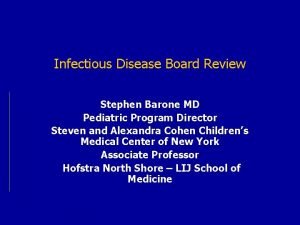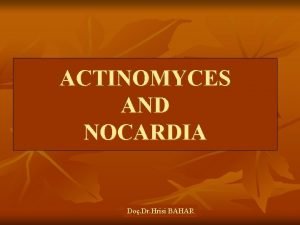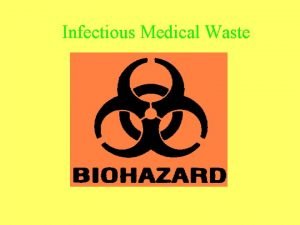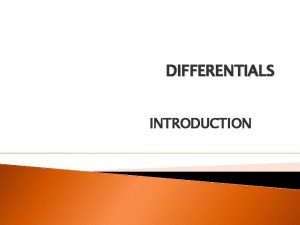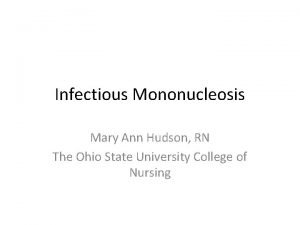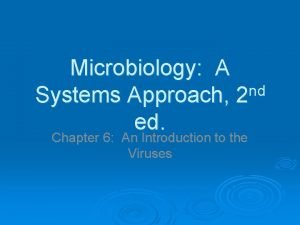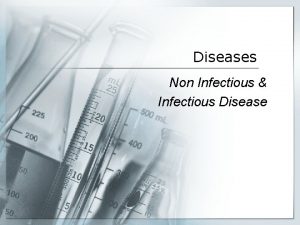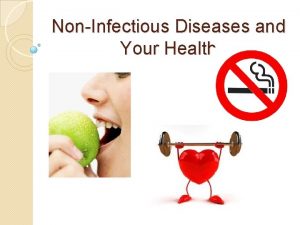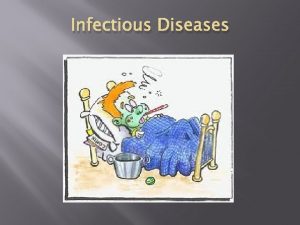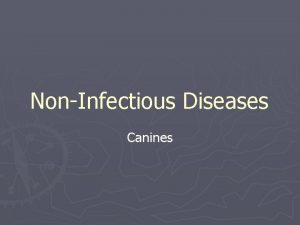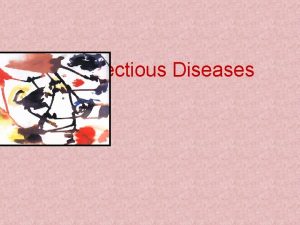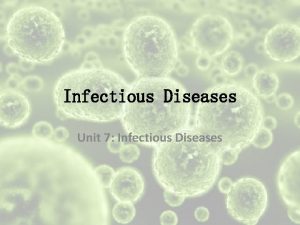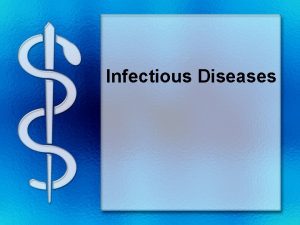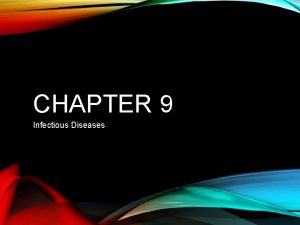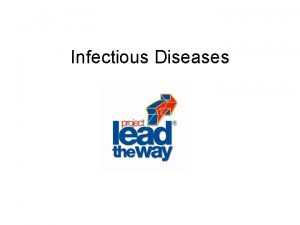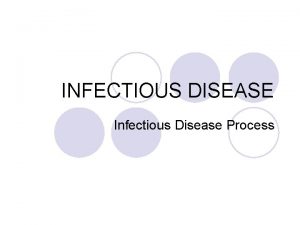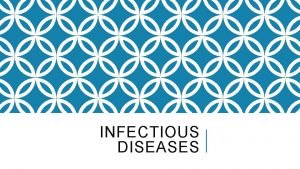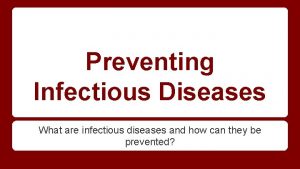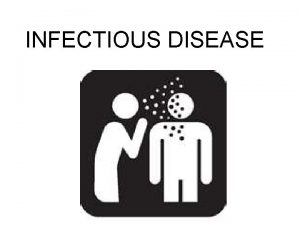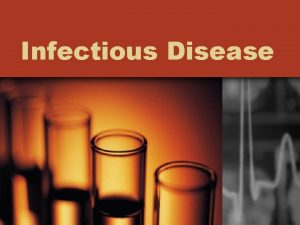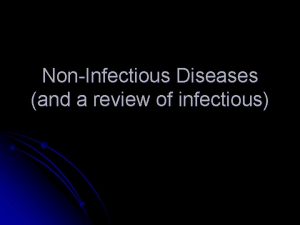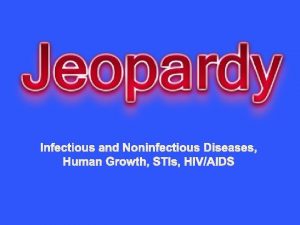Infectious and noninfectious disease NONINFECTIOUS DISEASE o Diseases































- Slides: 31

Infectious and noninfectious disease

NON-INFECTIOUS DISEASE o. Diseases that are not caused by a pathogen and cannot be shared from one person to another. o. Caused by the environment, nutritional deficiencies, lifestyle choices, or genetic inheritances. o. Not communicable or contagious, although some kinds can be passed down genetically to the children of a carrier.

Causes of non-infectious disease o. Causes are categorized into genetically inherited diseases and environmental diseases. o. Many diseases are affected by both genetic and environmental factors. o. Risk factors o Heredity (parents) o Chromosomal disorders o Age (over 40) o Exposure to environmental conditions (drugs, chemicals, sanitation, pollution) o Immunological competence o Economic status, geographical location o Stress o Nutrition o Physical inactivity

Inherited diseases o. Genetic disorders are caused by errors in genetic information that produce diseases in the affected people. o. These errors may include: o. A change in the chromosome numbers, such as Down syndrome o. A defect in a single gene caused by mutation, such as Cystic Fibrosis.

Environmental diseases o. Environmental disease is a very broad category. It includes: o Avoidable and unavoidable conditions caused by external factors, such as sunlight, food, pollution, and lifestyle choices. o. Examples include: o Many types of cardiovascular disease o Chronic obstructive pulmonary disease caused by smoking tobacco o Type 2 Diabetes o Malnutrition caused by too little food, or eating the wrong kinds of food (e. g. scurvy from lack of Vitamin C) o Skin cancer caused by radiation from the sun

Cancer o. Cancer is a non-infectious disease that affects millions of people. o. The National Cancer Institute reports the most common cancer type as nonmelanoma skin cancer, with about one million cases a year. o. Lung cancer is the second-most common, with about 219, 440 new cases and 159, 390 deaths. o Other common cancers include bladder, breast, leukemia, pancreatic, prostate, thyroid, colorectal, endometrial and kidney cancer.

Heart disease o. Mayo Clinic reports heart disease, a non-infectious disease, as the number-one killer in the United States. o. Heart or cardiovascular disease refers to a variety of conditions that involve the circulatory system. o. Heart attacks, strokes, chest pain, tachycardia, high cholesterol, heart valve disease, high blood pressure, palpitations and congenital heart disease are some of the non-infectious heart diseases.

Kidney disease o. The National Kidney Foundation reports chronic kidney disease (CKD) is a noninfectious disease that affects about 26 million Americans. o. CKD results when the kidneys are no longer able to remove wastes from the body. o. Diseases such as diabetes, high blood pressure, lupus, kidney stones and polycystic kidney disease may hinder the kidneys' ability to process and remove wastes.

Mental disease o. Mental disease covers a broad range of non-infectious diseases that affects people of all ages. o Autism, panic attacks, narcolepsy, manic-depressive disorder, depression, bulimia nervosa, bipolar disorder and Asperger's syndrome are examples of non-infectious mental diseases.

Bone disease o. Non-infectious bone diseases include osteoporosis, Paget's disease and osteogenesis imperfecta. o. Osteoporosis indicates a low bone mass, fragile bones, and high risk of bone fractures. o. Paget's disease presents as bones that grow larger and weaker than normal bones. o. Osteogenesis imperfecta (OI) is a non-infectious genetic disorder. OI symptoms include bones that break easily.

Muscle and joint disease o. Non-infectious muscle and joint diseases include fibromyalgia, rheumatoid arthritis and gout. o. Fibromyalgia is a chronic non-infectious disease identified as pain and tender points in soft tissue, muscles and joints throughout the body. o. Merck Manual, an online medical library, reports rheumatoid arthritis (RA) affects about one percent of the world's population. RA symptoms range from mild occasional joint pain to severe and debilitating pain. o. Gout is a non-infectious disease caused by high levels of uric acid in the joints and manifests as sudden severe joint pain, possibly accompanied by fever and feeling ill.

Diabetes o. When carbohydrates are eaten, they get converted to glucose which is blood sugar. o. To stabilize blood sugar levels, the pancreas releases insulin. o. In people that have diabetes, a noninfectious disease, the pancreas does not release insulin properly or at all in the most severe cases. o. This can cause kidney failure, blindness, nerve damage and heart problems. o. Type I and Type II

INFECTIOUS DISEASE o. Infectious diseases are caused by pathogenic microorganisms o. The diseases can be spread, directly or indirectly, from one person to another. o. Pathogens: ◦ ◦ ◦ Bacteria Viruses Fungi Protozoan Parasites

Bacteria versus viruses o. Bacteria o. Simple, single celled o. Found in air, soil, food, inside plants and animals o. Most don’t cause disease o. Those that do, enter the blood stream and/or cells and damage them with toxins o. Can be cured by antibiotics o. Viruses o Smallest pathogens o 100 x smaller than bacteria o Only multiply when living inside cells o Cannot be cured by medicines (in most cases), they only reduce the symptoms

Bacteria versus viruses

Methods of transmission o. Droplet Contact • Also known as the respiratory route, it is a typical mode of transmission among many infectious agents. • If an infected person coughs or sneezes on another person the microorganisms, suspended in warm, moist droplets, may enter the body through the nose, mouth or eye surfaces. o. Examples • Bacterial Meningitis, Chickenpox, Common cold, Influenza, Mumps, Strep throat, Tuberculosis, Measles, Rubella, Whooping cough

Methods of transmission o. Direct contact is rare in this route, for humans at least. o. More common are the indirect routes; foodstuffs or water become contaminated (by people not washing their hands before preparing food, or untreated sewage being released into a drinking water supply) and the people who eat and drink them become infected. o. In developing countries most sewage is discharged into the environment or on cropland as of 2006; even in developed countries there are periodic system failures resulting in a sanitary sewer overflow. o. This is the typical mode of transmission for the infectious agents of (at least): o Cholera o Hepatitis A o Polio o Rotavirus o Salmonella

Methods of transmission o. Sexual transmission o. This refers to any disease that can be caught during sexual activity with another person, including vaginal or anal sex or (less commonly) through oral sex. o. Transmission is either directly between surfaces in contact during intercourse (the usual route for bacterial infections and those infections causing sores) or from secretions (semen or the fluid secreted by the excited female) which carry infectious agents that get into the partner's blood stream through tiny tears in the penis, vagina or rectum (this is a more usual route for viruses). o. Some diseases transmissible by the sexual route include (at least): o o o o HIV/AIDS Chlamydia Genital warts Gonorrhea Hepatitis B Syphilis Herpes

Methods of transmission o. Transmission by direct contact o. Diseases that can be transmitted by direct contact are called contagious. These diseases can also be transmitted by sharing a towel (where the towel is rubbed vigorously on both bodies) or items of clothing in close contact with the body (socks, for example) if they are not washed thoroughly between uses. o. For this reason, contagious diseases often break out in schools, where towels are shared and personal items of clothing accidentally swapped in the changing rooms. o. Some diseases that are transmissible by direct contact include: o Athlete's foot o Impetigo (school sores) o Syphilis (on rare occasions, if an uninfected person touches a chancre) o Warts

Methods of transmission o. Vector borne transmission o. A vector is an organism that does not cause disease itself but that transmits infection by conveying pathogens from one host to another. o. Examples include mosquitoes, deer ticks, animal bites, etc.

Bacteria o. Single-celled organisms o. Causes disease by secreting toxins o. Thousands exist, but only approximately 100 cause disease in humans o. Three types: o Cocci o Bacilli o Spirochaete

Staphylococcal infections o. Present on our skin o. Break in epidermis allows Staphylococcus to invade o. Infected wounds / acne o. Strep throat (severe sore throat) o. Scarlet fever, acute fever, sore throat, rash o. Rheumatic fever o. Toxic Shock Syndrome

Pneumonia o. Bacterially caused o. Chronic cough, chest pain, chills, high fever, fluid accumulation in lungs

Viral infections o 1/500 th the size of bacteria o. Approximately 150 cause disease in humans o. Consist of protein structure - DNA or RNA o. No capacity for cellular function (i. e. respiration/metabolism) o. Unable to reproduce on their own or outside the body o. Parasitic relationship within cells invaded o. Take over cell reproductive process o. Instruct cells to produce new viral particles o. Viruses are released and enter other cells o. Difficult to culture in lab, and therefore detection and study difficult

Common cold o 100 + viruses cause it o. Colds can be caught via contact air-borne droplets, touching, mucus membrane contact, hands frequent contact of hands to mouth / nose

Influenza o. Influenza (Flu) o. Viral disorder of respiratory tract o. Symptoms include aches, pains, nausea, fever, etc. o 3 forms o. A - most virulent o. B - 2 nd most virulent o. C - 3 rd o. Concern for Older Adults

Hepatitis o. Virally induced inflammation of liver o. Symptoms = fever, headache, nausea, and loss of appetite, jaundice, and diarrhea o. Hepatitis A o "infectious hepatitis" o transmitted by fecal-oral route, bad hygiene o persons in contact with children in day-care settings o. Hepatitis B o transmitted by body fluids (blood, serum, saliva, semen, and vaginal fluids) o also transmitted by needle stick, contact with needles (drug users), and sexual contact o some patients may develop cirrhosis and/or cancer of the liver, and eventually death

Measles o. Viral disorder frequently affects young children o. German measles (rubella) is a milder viral infection transmitted by inhalation o. Can move into bloodstream o. Causes a rash o. Not serious, except for pregnant women and newborns o. Fetus in 1 st trimester may be born blind, deaf, retarded, or with congenital heart defects

Fungi o. Single or multi-celled organisms o. Mouldy breads, cheeses, and mushrooms o. Vaginal yeast infection, athlete's foot, ringworm, and jock itch o. Treatment: keep infected area dry and clean, and treat with antifungal antibiotics

Protozoa o. Single-celled microscopic organisms that release enzymes and toxins o. Destroying cells or interfering with their function o. Tropical diseases: malaria, sleeping sickness, giardia, leishmaniasis o. Treatment: relieve the symptoms, replace lost blood or fluid, and drug therapy

Parasitic worms o. Multi-cellular animals o. Attack specific tissues/organs and compete with host for nutrient o. Problem in developing countries o. Entering the body via uncooked meats o. Treat with drugs/surgery
 Icd 10 morbus hansen
Icd 10 morbus hansen Epidemiological triad of malaria
Epidemiological triad of malaria Chapter 26 infectious disease prevention and control
Chapter 26 infectious disease prevention and control Infectious disease quality controls
Infectious disease quality controls Periods of infectious disease
Periods of infectious disease Stages of infectious disease
Stages of infectious disease Stridor
Stridor Infectious disease
Infectious disease Hennepin county infectious disease manual
Hennepin county infectious disease manual Smallest infectious agent
Smallest infectious agent Hpps logo
Hpps logo Bharathi viswanathan
Bharathi viswanathan Infectious waste definition
Infectious waste definition Infectious canine hepatitis in dogs
Infectious canine hepatitis in dogs Papillomitosis
Papillomitosis Infectious nucleic acid
Infectious nucleic acid University of washington
University of washington Infectious mononucleosis
Infectious mononucleosis Quizlet
Quizlet Infectious stunting syndrome
Infectious stunting syndrome Lifestyle modern
Lifestyle modern Is athlete's foot communicable or noncommunicable
Is athlete's foot communicable or noncommunicable Section 19-3 diseases caused by bacteria and viruses
Section 19-3 diseases caused by bacteria and viruses Chapter 8 skin disorders and diseases review questions
Chapter 8 skin disorders and diseases review questions Chapter 6 musculoskeletal system
Chapter 6 musculoskeletal system Chapter 24 sexually transmitted diseases and hiv/aids
Chapter 24 sexually transmitted diseases and hiv/aids Chapter 22 genetics and genetically linked diseases
Chapter 22 genetics and genetically linked diseases Chapter 21 mental health diseases and disorders
Chapter 21 mental health diseases and disorders Chapter 17 reproductive system diseases and disorders
Chapter 17 reproductive system diseases and disorders Chapter 15 nervous system diseases and disorders
Chapter 15 nervous system diseases and disorders Milady chapter 10 nail disorders and diseases
Milady chapter 10 nail disorders and diseases Chapter 8 skin disorders and diseases
Chapter 8 skin disorders and diseases






